Raw fruits and vegetables have been known to serve as
vehicles of human disease for at least a century. In 1899,
Morse linked typhoid infection to eating celery. Warry
(1903) attributed an outbreak of typhoid fever to eating
watercress grown in soil fertilized with sewage and
Pixley (1913) recorded two cases of typhoid from eating uncooked rhubarb which
was grown in soil known to have been fertilized with typhoid excreta.
One person can harbor a parasite without ever
knowing it, another person could be infected with
the same parasite and feel completely devastated
and fatigued, without ever knowing that a parasitic
infection is at the root of a lingering illness.
Why is this? When the immune system is weakened
by fatigue Medical Drugs,poor diet, and recreational
drugs there is always the danger of initiating
an inflammatory cascade throughout the body.
This is especially true of the gut, which has a direct line of
communication to the brain via the vagus nerve.
|
In 1912, Creel demonstrated that lettuce and radishes grown in soil containing
Bacillus typhosa (now Salmonella Typhi) harboured the organism on their
surfaces for up to 31 days. Melick (1917) recovered typhoid bacilli from
mature lettuce and radish harvested from soil that had been inoculated
at the time seeds were planted. Some parasitic helminths (e.g. Fasciola
hepatica, Fasciolopsis buski) require encystment on plants to complete
their life cycle. Thus, the recognition of raw fruits and vegetables
as potential vehicles for transmission of pathogenic microorganisms known
to cause human disease is not new.
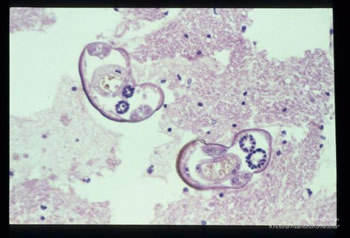 |
Beware of getting rat lung worm
brain parasite infection from eating unwashed salad
vegetables
Angiostrongylus cantonensis |
Raw and minimally-processed fruits and vegetables are
an essential part of peoples diet all around the world.
Where land is available, families grow fruits and vegetables
for their own use. Alternatively, produce is purchased
from local farmers or retail outlets for further preparation
by street vendors, by families at home or as part of
meals eaten in restaurants and other food-service facilities.
While advances in agronomic practices, processing, preservation,
distribution and marketing have enabled the raw fruit
and vegetable industry to supply high-quality produce
to many consumers all year round, some of these same
practices have also expanded the geographical distribution
and incidence of human illness associated with an increasing
number of pathogenic bacterial, viral and parasitic microorganisms.
Parasites do not like the following: unrefined
carbohydrates, raw green vegetables, bitter melons,
tomatoes, black pepper, raw carrots and their tops,
fresh horseradish, onions, vegetable proteins,
high fiber, radishes, kelp, raw cabbage, ground
almonds, blackberries, figs, and alkaline diets.
In addition, roundworms can be expelled with rose
hip tea, and raisins soaked in senna tea makes
for faster elimination of parasites in children.
In Mexico, fresh pineapple and papaya are used
to cure worm infestations, and the seeds are often
chewed to eliminate parasites. |
In recent years, the frequency of outbreaks epidemiologically
associated with raw fruits and vegetables is documented
to have increased in some industrialized countries (e.g
the United States) as a result of change in dietary habits
and increased import of food (Altekruse et al., 1997).
In developing countries, foodborne illnesses caused by
contaminated fruits and vegetables are frequent and in
some areas they cause a large proportion of illness.
Most
people are not aware of the danger to their health
posed by parasites;
Changes that may contribute to the increase in diseases
associated with the consumption of raw fruits and vegetables
in industrialized countries (Hedberg et al., 1994) and
foods in general (Altekruse and Swerdlow, 1996; Altekruse
el al., 1997; Potter et al., 1997) have been described.
Factors include globalization of the food supply, inadvertent
introduction of pathogens into new geographical areas
? e.g. outbreaks of shigellosis in Norway, Sweden and
the United Kingdom in 1994 due to contaminated lettuce
imported from southern Europe (Frost et al., 1995; Kapperud
et al., 1995) and cyclosporiasis in the United States
which was linked to consumption of contaminated raspberries
imported from Guatemala (Centers for Disease Control
and Prevention, 1996c) ? and the development of new virulence
factors by microorganisms, decreases in immunity among
certain segments of the population, and changes in eating
habits. In developing countries, continued use of untreated
wastewater and manure as fertilizers for the production
of
The ingestion of raw vegetables represents
an important means of transmission for several
infectious diseases. The objectives of the present
survey were to perform a parasitological evaluation
of vegetables sold commercially in greengrocers
in Urmia City, which were consumed raw, and to
analyze the presence of human and livestock parasitic
eggs, larvae, cysts, and oocysts; to determine
the greater percentages and the season of contamination;
to identify the parasites by morphology and micrometry.
First, both sides of the vegetable leaves
were washed carefully with a hard brush, and
then each unit or bundle was washed with
50 ml of sterilized water More |
Fruits and vegetables can become contaminated
with microorganisms capable of causing human diseases
while still on the plant in fields or orchards, or during
harvesting, transport, processing, distribution and marketing,
or in the home. Figure 1 shows potential mechanisms by
which pathogenic microorganisms can contaminate vegetables.
Bacteria such as Clostridium botulinum, Bacillus cereus
and Listeria monocytogenes, all capable of causing illness,
are normal inhabitants of many soils, whereas Salmonella,
Shigella, Escherichia coli and Campylobacter reside in
the intestinal tracts of animals, including humans, and
are more likely to contaminate raw fruits and vegetables
through contact with faeces, sewage, untreated irrigation
water or surface water. Contamination may also occur
during post-harvest handling, including at points of
preparation by street vendors, in food-service establishments
and in the home. Contamination with viruses or parasites
can result from contact with faeces, sewage and irrigation
water (Cliver, 1997; Speer, 1997).
The microorganisms
normally present on the surface of raw fruits and
vegetables may consist of chance Contaminants from
the soil or dust, or bacteria or fungi that have
grown and colonized by utilizing nutrients exuded
from plant tissues. Among the groups of bacteria
commonly found on plant vegetation are those that
test positive for coliforms or faecal
coliforms ? e.g. Klebsiella and
Enterobacter (Duncan and Razzell, 1972; Splittstoesser et al., 1980;
Zhao et al., 1997). |
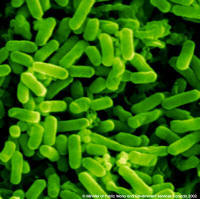
Fecal coliform bacteria are a kind of total
coliform. The feces (or stool) and digestive
systems of humans and warm-blooded animals contain
millions of fecal coliforms. E. coli is part
of the fecal coliform group and may be tested
for by itself. These harmful germs can cause
diarrhea, dysentery, and hepatitis.
|
Many factors, may contribute to real increases
in diseases associated with fruits and vegetables (Hedberg
et al., 1994). These include use of wastewater, increased
application of improperly composted manures to soils
in which fruits and vegetables are grown, changes in
packaging technology such as the use of modified or controlled
atmosphere and vacuum packaging, extended time between
harvesting and consumption, and changing food consumption
patterns (e.g. eating more meals away from home, including
greater use of salad bars). Increased global trade in
raw fruits and vegetables, as well as increased international
travel in general, could also increase the risk of produce-associated
diseases. Finally, the susceptibility of the public to
foodborne diseases, at least in more developed countries,
is changing due to increased numbers of people who are
elderly, immunocompromised or have chronic diseases.
This change in social demographics is likely to lead
to increased risk of illness associated with the consumption
of raw produce that otherwise may contain levels of pathogens
innocuous to healthy individuals.
One of the most common parasites
to infect human beings is the yeast-like Blastocystis
hominis, a single-celled parasitic organism that causes
abdominal cramping, bloating, gas, and sometimes anal
itching.
 Pathogens
of most concern Pathogens
of most concern
Other common parasites are:
 Tapeworms, which can grow as long as 60 feet
while living in the human intestines. There are currently
more than 5,000 different species of tapeworm. Tapeworms, which can grow as long as 60 feet
while living in the human intestines. There are currently
more than 5,000 different species of tapeworm.
 Hookworms. If given the chance, they will suck blood from our intestinal
walls. Hookworms. If given the chance, they will suck blood from our intestinal
walls.
 Giardia, a single-celled parasite that is usually the result of drinking
infected waters. It typically survives in chlorinated water and commonly lives
in mountain streams, earning it the name, “backpacker’s diarrhea.” About
2.5 million cases are reported annually. Giardia, a single-celled parasite that is usually the result of drinking
infected waters. It typically survives in chlorinated water and commonly lives
in mountain streams, earning it the name, “backpacker’s diarrhea.” About
2.5 million cases are reported annually.
 Blood flukes. They mature first in snails and then complete their life
cycle by burrowing through human skin and swimming through veins. Blood flukes
infect more than 200 million people. There are also other species of flukes found
living in the liver, lungs, and pancreas. Blood flukes. They mature first in snails and then complete their life
cycle by burrowing through human skin and swimming through veins. Blood flukes
infect more than 200 million people. There are also other species of flukes found
living in the liver, lungs, and pancreas.
 In the case of malaria, a new generation of parasitic microbugs will
burst from a single red blood cell. In the case of malaria, a new generation of parasitic microbugs will
burst from a single red blood cell.
 Pinworms, the most common roundworm in the United States. Worldwide,
roughly 209 million people are infected. (2) The most common sign of pinworm
infestation is anal itching at night, which is when the female pinworm migrates
to the perineum to lay her eggs. Children are the most common carriers. Pinworms, the most common roundworm in the United States. Worldwide,
roughly 209 million people are infected. (2) The most common sign of pinworm
infestation is anal itching at night, which is when the female pinworm migrates
to the perineum to lay her eggs. Children are the most common carriers.
 |
A hookworm is a common
parasite that will suck blood from intestinal walls.
In many cases, you could be carrying a parasite without
even knowing it! |
 If
you have any of these Symptoms, If
you have any of these Symptoms, |
Salmonellae have been isolated from many
types of raw fruits and vegetables (Beuchat, 1996b; Wells
and Butterfield, 1997). Outbreaks of salmonellosis have
been linked to a diversity of fruits and vegetables,
including tomatoes (Centers for Disease Control and Prevention,
1993; Hedberg et al., 1993; Wood et al., 1991), bean
sprouts (Mahon et al., 1996; O?Mahony et al., 1990; Van
Venedey et al., 1996), melons (Blostein, 1991; Centers
for Disease Control and Prevention, 1979; 1991; Gaylor
et al., 1955; Ries et al., 1990), unpasteurized orange
juice (Cook et al., 1990) and apple juice (Centers for
Disease Control and Prevention, 1975). The pathogen can
grow on the surface of alfalfa sprouts (Jaquette et al.,
1996), tomatoes (Zhuang et al., 1995) and perhaps on
other mature raw fruits and vegetables, making it imperative
to use hygienic practices when handling them.
Prevention
of contamination of fruits and vegetables with pathogenic
microorganisms should be the goal of everyone
This is a very difficult task, since some
pathogens are normally present in the soil and may therefore
be present on the surface of fruits and vegetables when
they are harvested. In addition, inadequate water resources
may encourage the use of unsafe water to make ice or
raw
sewage to irrigate fields. Farm environments are not and cannot be aseptic.
The simple practice of washing raw fruits
and vegetables in hot water or water containing detergent
or permanganate salts removes a portion of the pathogenic
and spoilage microorganisms that may be present, but
studies showing the efficacy of these treatments are
few.Viruses and protozoan cysts on fruits and vegetables
generally exhibit higher resistance to disinfectants
than do bacteria or fungi.
Reduction
in the chances of contamination can be achieved,
through simply Ozonating your fruits and vegetables

Treatment of drinking-water with ozone
for the purpose of killing microorganisms has been practised
for nearly a century. Salmonella Typhimurium, Y. enterocolitica,
S. aureus, and L. monocytogenes are among the pathogens
sensitive to treatment in ozonated (20 ppm) water (Restaino
et al., 1995). Enteric viruses (Finch and Fairbairn,
1991) and oocysts of protozoa such as 24 WHO/FSF/FOS/98.2
Cryptosporidium parvum (Korich et al., 1989) are also sensitive to ozone.
Greater than 90% inactivation of C. parvum was achieved by treatment
with 1 ppm ozone for 5 minutes (Peeters et al., 1990). C. parvum oocysts
are about 30 times more resistant to ozone and 14 times more resistant
to ClO2 than Giardia cysts under the same conditions.
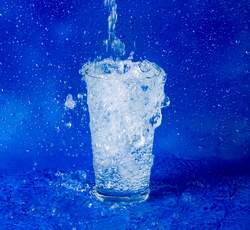
Incidence of parasites found on vegetables
collected from markets and vegetable gardens in
Taegu area.
Choi DW, Lee S.
SourceDepartment of Parasitology, Kyungpook National University School
of Medicine, Taegu, Korea.
Abstract
A parasitic survey on vegetables collected from markets and vegetable
gardens in Taegu area was conducted for the discovery of human
parasitic eggs and larvae. Three species of vegetable, lettuce
(Lactuca sativa), young radish(Raphanus sapivus) and Chinese
cabbage (Brassica pekinensis) were selected. All vegetable
leaves were washed with a hard brush, and then species of parasites
and the approximate mean number of parasitic eggs per 200 grams
of vegetable leaves were investigated. When vegetables collected
from markets were examined, 5 species of parasite eggs (ascarid,
trichurid, Trichostrongylus, Clonorchis and hookworms) and
2 larvae (filariform and rhabditoid ) were found. Furthermore,
a number of eggs and larvae of undetermined species were also
observed. Of the parasites studied, ascarid egg was found to
be highest (49.0%), followed Trichostrongylus egg(18.0%) as
well as filariform larva of hookworms (19.7%), and the least
often observed was rhabditoid larva of hookworms(0.7%). The
recovery rate of parasites among lettuce, young radish and
Chinese cabbage collected from markets ranged from 23.2 to
91.9 percent and was similar to that from vegetable gardens,
where Chinese cabbage showed the highest (91.1%) and lettuce
being next(49.0%) in positivity of ascarid eggs. In the case
of filariform larva, the rate of Chinese cabbage was twice
as high as that of lettuce and young radish. There was a significant
reduction in the rate of filariform larva, suggesting that
a single washing of vegetables at the vegetable washing stand
would reduce the number of parasites attached to vegetable
leaves, when young radish washed at the stand was compared
with that unwashed. In the monthly rate of parasites recovered
from young radish, there was significant fluctuations between
the eggs and filariform larva of hookworms. The mean number
of ascarid egg per 200 grams of vegetable was 7.5 in young
radishes, 3.1 in lettuces, and 0.5 in Chinese cabbages, in
decreasing order. It is noteworthy that young radish contained
more than 10 times more than Chinese cabbage. These results
would seem to indicate that one of the important routes of
infection is due to consumption of pickled young radishes in
summer than pickled Chinese cabbages in winter.
PMID:12913510[PubMed - as supplied by publisher] |

The use of ozone to disinfect various types
of foods has been investigated. Preservation of fish
(Haraguchi et al., 1969), reduction of aflatoxin in peanuts
and cottonseed meals (Dwankanath et al., 1968), reduction
of microbial populations on poultry (Sheldon and Brown,
1986), and
reduction of microbial populations on bacon, beef, butter, cheese, eggs,
mushrooms, potatoes and fruits (Gammon and Kerelak, 1973; Kaess and Weidemann,
1968) using gaseous ozone have been studied. High relative humidity or
aqueous conditions generally favour microbicidal activity. The lethal
effect of ozone is a consequence of its strong oxidizing power.
What
is Ozone |
Testimonials
| Ozone can be used for the reduction,
or elimination of L. monocytogenes on
food products. Since
achieving GRAS approval for the use
of ozone for direct contact with food
in 2001 the use of ozone for the elimination
of L. monocytogenes has increased significantly. |
|
Extension of shelflife of oranges, strawberries,
raspberries, grapes, apples and pears can be achieved
by treatment with ozonated water. In addition to the
antimicrobial effects of ozone, oxidation of ethylene
also occurs, thus retarding metabolic processes associated
with ripening. Concentrations in the range of 2-3 ppm
for berry fruits and 40 ppm for oranges greatly reduce
microbial populations.
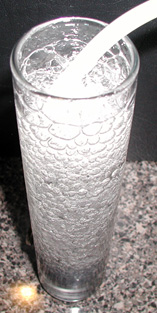
Because of its instability, ozone must
be generated at the usage site. The use of ozonated wash
and flume-waters
in fruit and vegetable handling and processing operations provides a
method to control build-up of microbial numbers, particularly in recycled
water, and deserves consideration for routine use as a disinfectant for
fruits and vegetables.
When using Ozone, do not use water
over 80° F. Ozone treatments with colder water
are more effective in sanitizing food..
 Better
for your food and health by removing toxins. Better
for your food and health by removing toxins.
 Decontaminates
meat, poultry and seafood. Decontaminates
meat, poultry and seafood.
 Neutralise's
pesticide residues and microbes on fresh fruit
and vegetables. Neutralise's
pesticide residues and microbes on fresh fruit
and vegetables.
 Eliminates
germs, bacteria and mould.. Eliminates
germs, bacteria and mould..
 Food
lasts up to four times longer and tastes better. Food
lasts up to four times longer and tastes better.
 Baby
bottle cleaning . Baby
bottle cleaning .
 Better
for your home and family with 100% chemical-free
cleaning. Better
for your home and family with 100% chemical-free
cleaning.
 Turns
tap water into an odorless and safe sanitizer/sanitiser
and deodoriser. Turns
tap water into an odorless and safe sanitizer/sanitiser
and deodoriser.
 Sanitizes/sanitises
everyday kitchen items including sponges, toys,
pacifiers, baby bottles and work surfaces. Sanitizes/sanitises
everyday kitchen items including sponges, toys,
pacifiers, baby bottles and work surfaces.
 Safe
for babies, pets and people with allergies and
sensitive skin. Safe
for babies, pets and people with allergies and
sensitive skin.
 Save
money on chemical household cleaning products. Save
money on chemical household cleaning products.
 Neutralise's
bacteria 3,000 times faster and 50% stronger
than bleach. Neutralise's
bacteria 3,000 times faster and 50% stronger
than bleach.
Does
Ozone harm Healthy cells ?
"The different
modes of action of ozone on a living organism
are now well understood. The production of
peroxides is responsible for the remarkable
bactericidal and fungicidal effects of ozone.
The virus inactivation is enhanced by a peroxide
intolerance of weakened infected cells.
Normal cells are protected
from the effects of ozone by enzymes in the
cell wall - glutathione peroxidase, catalase
and superoxide dismutase. Ozone stimulates
the production of these enzymes, thus enhancing
the cell wall resistance to invasion." Fritz
Schellander |
 |
Water
Ozonator 600mg/hr
The
Best Home/Office unit we have used
|
Feel
like you Already have Parasites!!!
If
you have any of these Symptoms, |
Bob
Beck Protocol
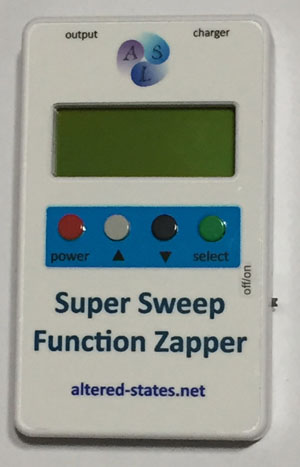 |
Hulda
Clarke type Zapper
SUPER SWEEP-FUNCTION ZAPPER
 Sweeps
up and down the 26khz -34khz range, Sweeps
up and down the 26khz -34khz range,
 Sweeps
up and down the 2.3-2.7khz range Sweeps
up and down the 2.3-2.7khz range
 Can
sweep both ranges separately Can
sweep both ranges separately
 Can
sweep both ranges consecutively,
complete coverage Can
sweep both ranges consecutively,
complete coverage
 Auto-timer
on Mode (7 minutes on, 20 minutes
off, 7 minutes on, 20 minutes
off, 7 minutes on ) Auto-timer
on Mode (7 minutes on, 20 minutes
off, 7 minutes on, 20 minutes
off, 7 minutes on )
|
 |
Combo
Pulser
 Blood
Zapper (Bob
Beck Protocol) Blood
Zapper (Bob
Beck Protocol)
 Colloidal
Silver Generator (Bob
Beck Protocol) Colloidal
Silver Generator (Bob
Beck Protocol)
|
 |
Tri
Pulsar 3
 Blood
Zapper (Beck Protocol) Blood
Zapper (Beck Protocol)
 Colloidal
Silver Generator (Beck Protocol) Colloidal
Silver Generator (Beck Protocol)
 Magnetic
Pulser (Micro pulse) Magnetic
Pulser (Micro pulse)
 |
 |
Tri-Pulsar
9
 Functions Functions
 High
Powered Bob Beck Type Magnetic Pulsar High
Powered Bob Beck Type Magnetic Pulsar
 Constant
Current Colloidal Silver Generator Constant
Current Colloidal Silver Generator
 Bob
Beck Type Blood Zapper Bob
Beck Type Blood Zapper
 Digital
Timer 5 mins - 2 Hours Digital
Timer 5 mins - 2 Hours
 Silver
Rods Silver
Rods
 Velcro
Wrist Strap Velcro
Wrist Strap
 Blood
Zapper Electrodes Blood
Zapper Electrodes
 Hand
Held Hand
Held
 Built
in Stand Built
in Stand
 Easy
Instructions Easy
Instructions
 120-240
Volts (The correct voltage
is sent for your country) 120-240
Volts (The correct voltage
is sent for your country)
 |
Sources and References
|

